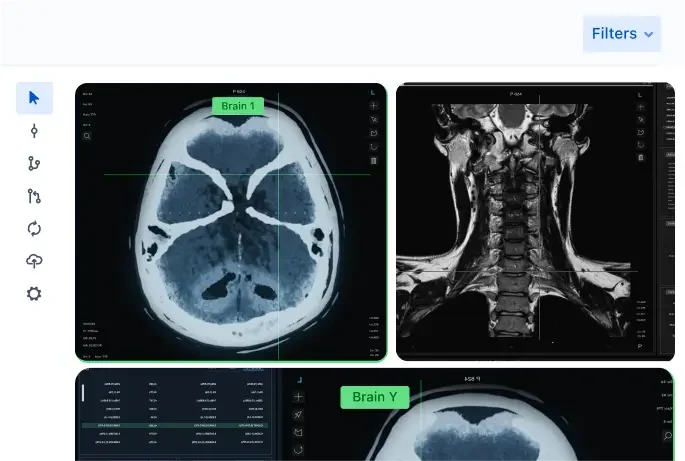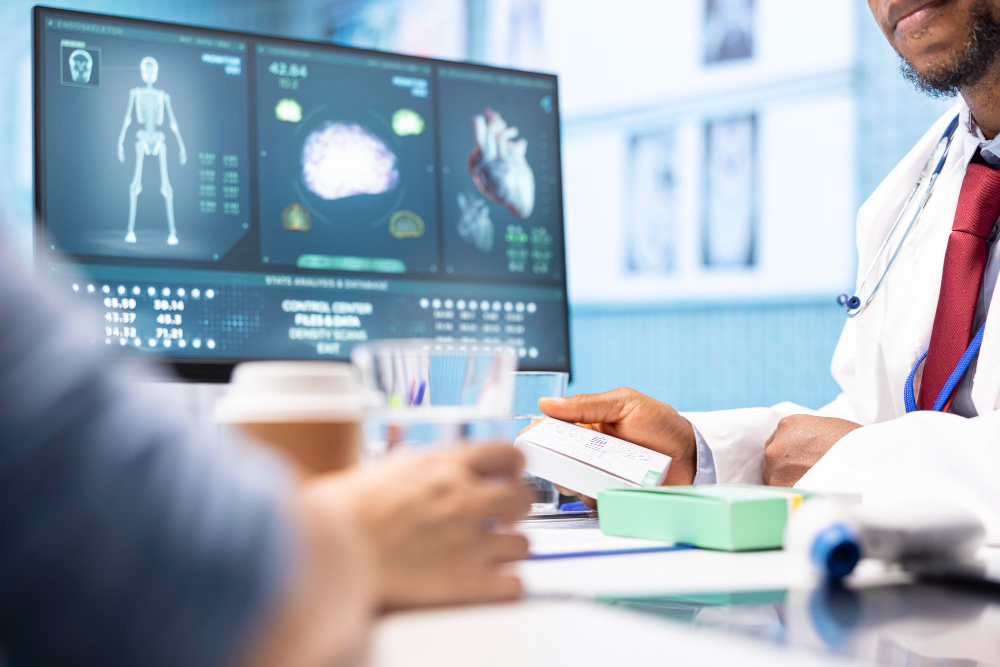Medical Imaging AI Software Developer: The rise of AI in medical imaging is transforming healthcare, opening new doors for diagnosis and treatment.
Medical Imaging AI Software Developers are at the forefront of this change. They build the tools that allow doctors to see inside the human body with unprecedented clarity. Their work is crucial in detecting diseases early, planning treatments, and improving patient outcomes.
These developers need a mix of skills. They must understand both technology and medicine. They create software that learns from vast amounts of medical data. It helps doctors make more accurate decisions. This field is exciting and challenging. It combines cutting-edge technology with the noble goal of saving lives. Developers in this area are shaping the future of medicine. They play a vital role in improving healthcare for everyone.

Credit: www.folio3.ai
Introduction To Ai In Medical Imaging
AI in medical imaging is changing the way we approach diagnosis and treatment. Picture this: you walk into a hospital and the doctor uses AI-powered tools to analyze your scans instantly. This isn’t science fiction; it’s happening now. AI is making diagnosis faster and more accurate, saving lives and reducing healthcare costs.
Impact On Healthcare
AI is boosting healthcare efficiency and accuracy. Imagine a world where radiologists can focus on complex cases because AI handles routine analysis. This technology helps reduce human error, offering precise insights into patient conditions. Have you ever wondered how much quicker you could receive a diagnosis?
AI is not just about speed; it’s enhancing patient care. By identifying patterns and anomalies in images, AI can alert doctors to potential issues early. This proactive approach helps in managing diseases before they become critical.
Advancements In Technology
Technology in AI medical imaging is advancing rapidly. Developers are creating algorithms that learn and adapt, improving over time. These advancements mean more sophisticated tools for analyzing images with higher accuracy.
New software uses machine learning to detect diseases at stages previously undetectable. Have you ever thought about how early detection could change the outcome of a disease? AI’s ability to learn from vast amounts of data is key to these breakthroughs.
Imagine AI software that can differentiate between types of tissue in a scan. This precise differentiation helps doctors make informed decisions. It’s not just about replacing human judgment, but augmenting it with data-driven insights.
How do you think AI will continue to shape the future of medical imaging? Your thoughts and experiences might be more relevant than you think. Let’s keep the conversation going and explore the possibilities together!
Role Of Ai Software Developers
The role of AI software developers in medical imaging is crucial. They create software that assists in diagnosing diseases through images. These developers work on algorithms that enhance image analysis. Their work supports doctors by providing precise image interpretations.
Skill Set Required
AI software developers need strong programming skills. They must understand machine learning and data science. Knowledge of medical imaging techniques is essential. Developers should be familiar with neural networks and deep learning. Problem-solving skills are vital for tackling complex tasks. Communication skills help in explaining technical details to medical staff.
Challenges Faced
AI developers face significant challenges in medical imaging. One challenge is handling large datasets effectively. Ensuring data privacy and security is another major concern. Developers must also deal with varied image formats and qualities. Keeping algorithms accurate and reliable requires continuous testing. Staying updated with technology trends is essential for success.
Innovative Ai Applications
Medical imaging has witnessed a transformative shift with the advent of AI applications. These innovative tools are reshaping how diseases are detected and diagnosed, offering new possibilities in healthcare. As an AI software developer, you have the opportunity to be at the forefront of this technological wave, contributing to more precise and timely medical interventions.
Early Disease Detection
Imagine catching a disease before it progresses to a critical stage. AI in medical imaging makes this a reality by analyzing vast amounts of data rapidly and accurately. This technology can identify subtle patterns in imaging that may be missed by the human eye.
For example, AI algorithms can detect early signs of cancerous growths, enabling doctors to start treatment sooner. This capability not only saves lives but also reduces healthcare costs. Are you ready to contribute to such life-saving advancements?
Enhanced Diagnostic Accuracy
Accuracy in diagnosis is crucial, and AI applications are pushing the boundaries of what’s possible. With machine learning, medical imaging AI software can learn from thousands of examples to improve diagnostic precision. This continuous learning process enhances the reliability of results.
Consider how AI-driven tools assist radiologists by highlighting areas of concern in images, thus reducing human error. This collaboration between humans and machines leads to better patient outcomes. How would you feel knowing your work directly impacts the quality of healthcare?
Innovative AI applications are not just about technology; they are about changing lives. As you develop these tools, you are not just creating software but also building a bridge to better health for countless individuals. What role will you play in this exciting journey?

Credit: testdynamics.net
Benefits To Patients And Physicians
Medical imaging AI software is transforming healthcare. It offers significant benefits to both patients and physicians. Advanced algorithms analyze medical images quickly. This leads to better diagnostics and treatments.
Improved Patient Outcomes
AI software enhances accuracy in diagnosis. Early detection of diseases becomes possible. This improves patient outcomes significantly. Timely interventions save lives and reduce complications. Patients receive personalized treatment plans. AI predicts disease progression effectively. It suggests optimal treatment strategies.
Efficiency In Clinical Workflows
AI streamlines clinical workflows. It automates routine tasks. This reduces the burden on healthcare professionals. Physicians focus more on patient care. Diagnostic processes become faster. AI software reduces waiting times for patients. It ensures quicker access to necessary treatments. Overall, it enhances healthcare efficiency.
Ethical Considerations
Medical Imaging AI Software Developer is transforming healthcare. Yet, ethical considerations are crucial. These considerations ensure fair and safe use of AI. Two primary areas of concern are data privacy and AI bias. Addressing these can enhance trust and effectiveness.
Data Privacy Concerns
Data privacy is a significant issue in medical imaging AI. Patient data must be protected. Unauthorized access could breach privacy rights. Developers should implement strong security measures. Encryption and anonymization are vital. They help in safeguarding sensitive information. Regular audits can ensure compliance. This protects both patients and developers.
Ai Bias And Fairness
AI bias can affect medical imaging outcomes. Algorithms may favor certain groups. This leads to unfair treatment for others. Developers must aim for unbiased AI. Training data should be diverse. Diverse data helps in reducing bias. Regular testing can identify bias early. Fair AI improves patient trust and care quality.
Future Trends In Medical Imaging Ai
Medical imaging AI software developers shape the future of healthcare by creating tools for faster, precise diagnosis. These innovations help doctors see details, improving patient care and treatment plans. Enhanced algorithms enable the analysis of complex images, driving efficiency in medical practices worldwide.
The world of medical imaging AI is rapidly evolving, shaping the future of healthcare in ways we couldn’t have imagined a decade ago. With technology advancing at lightning speed, the integration of AI in medical imaging is not just a possibility; it’s a necessity. As a developer in this field, you have the chance to innovate and contribute to groundbreaking changes. But what does the future hold? Let’s dive into some emerging trends that are set to redefine medical imaging AI.
###
Integration With Wearable Technology
Imagine a world where your smartwatch doesn’t just track your steps, but also plays a crucial role in your healthcare. Wearable technology is becoming more sophisticated, and its integration with AI in medical imaging is opening new doors. You could be wearing a device that monitors your vital signs and sends data directly to your healthcare provider.
The real-time data collected by wearables can be analyzed using AI, providing insights into your health status. This means quicker diagnoses and personalized treatment plans, all accessible from the comfort of your home. Are you ready to see your watch transform into a health assistant?
###
Personalized Medicine
Personalized medicine is not just a buzzword; it’s the future of healthcare. With AI in medical imaging, treatments can be tailored specifically to you, based on your unique genetic makeup and lifestyle. Have you ever wondered why a medication works for some but not for others? AI helps in understanding these nuances by analyzing large datasets and identifying patterns.
Imagine AI software that predicts which treatment will be most effective for you before you even start it. This potential reduces trial-and-error, saving time and improving outcomes. How would it feel to know that your treatment plan is as unique as you are?
As a medical imaging AI software developer, you’re at the forefront of these innovations. Your work not only advances technology but impacts lives by making healthcare more efficient and personalized. What trends are you most excited about?
Collaboration Between Ai Developers And Healthcare Professionals
AI developers and healthcare professionals work together to create medical imaging software. This collaboration enhances diagnosis accuracy and speeds up treatment. By combining expertise, they develop tools that help doctors see images clearly and make better decisions.
Collaboration between AI developers and healthcare professionals is reshaping the future of medical imaging. This partnership blends cutting-edge technology with clinical expertise to improve patient outcomes. When these two fields converge, they create powerful tools that are more intuitive and effective. But how does this collaboration truly work? Let’s dive into the dynamics of interdisciplinary teams and continuous learning.
Interdisciplinary Teams
The magic happens when diverse minds come together. You might wonder how a software engineer and a radiologist collaborate. Imagine sitting in a room with a radiologist explaining the nuances of interpreting an MRI scan. As an AI developer, your role is to translate that into algorithms that can assist in diagnosis.
This collaboration requires trust and open communication. It’s about understanding each other’s language and finding common ground. Sharing insights leads to innovative solutions that neither party could achieve alone.
Continuous Learning And Adaptation
AI in healthcare isn’t static; it’s a living, evolving entity. Developers must stay updated with medical advancements, while healthcare professionals need to understand AI’s capabilities. This requires a commitment to continuous learning from both sides.
Consider the scenario where a new medical imaging technique is introduced. An AI developer must adapt software to accommodate this innovation. Conversely, healthcare professionals need to learn how to utilize these enhanced tools effectively.
How do you keep pace with rapid advancements? By fostering a culture of lifelong learning and adaptation. Attend workshops, engage in discussions, and never stop asking questions. This dynamic approach ensures that AI tools remain relevant and impactful in patient care.
In the end, collaboration between AI developers and healthcare professionals isn’t just about creating software. It’s about driving healthcare forward with shared knowledge and continuous growth. Are you ready to be part of this transformative journey?

Credit: www.ominext.com
Conclusion: Transforming Healthcare
Healthcare is transforming through innovative medical imaging AI software. Developers create tools that improve diagnosis accuracy and speed. This technology streamlines processes, enhancing patient care and outcomes.
The journey of medical imaging AI software development shows how technology reshapes healthcare. As the world advances, you see how AI tools provide timely solutions, improving patient outcomes and streamlining processes. This transformation is not just a fleeting trend; it’s a long-term commitment to better healthcare.
Long-term Impact
AI in medical imaging offers lasting benefits. It reduces the time doctors spend analyzing images, allowing them to focus on patient care. It also helps detect diseases earlier, which can save lives and reduce treatment costs.
Think about how quickly technology evolves. AI tools in healthcare keep getting smarter and more precise. This constant improvement ensures that healthcare systems remain efficient and effective for years to come.
Global Reach And Accessibility
AI software in medical imaging isn’t confined to developed countries. It bridges gaps in healthcare access, reaching remote areas where medical expertise is scarce. This means more people can receive accurate diagnoses, regardless of their location.
Consider a small clinic in a rural area. With AI tools, they can provide services that were once only available in big city hospitals. Such accessibility empowers healthcare professionals to offer quality care everywhere.
As you reflect on these advancements, think about your role in this healthcare evolution. How can you contribute to making these technologies more widespread? The future of healthcare is bright, and together, we can make it accessible to everyone.
Frequently Asked Questions
What Type Of Ai Is Used In Medical Imaging?
Medical imaging uses AI types like deep learning, machine learning, and neural networks. These technologies enhance image analysis, assist in accurate diagnostics, and improve patient outcomes. AI algorithms identify patterns, detect anomalies, and support radiologists in interpreting complex medical images efficiently.
How Much Do Medical Imaging Software Engineers Make?
Medical imaging software engineers earn between $80,000 and $120,000 annually. Salaries depend on experience, location, and company size. High-demand skills in AI and machine learning may increase earnings. Benefits often include health insurance and bonuses.
What Is The Average Salary Of An Ai Software Developer?
AI software developers typically earn between $100,000 and $150,000 annually. Salaries vary based on experience, location, and company size.
Will Ai Replace Medical Imaging?
AI enhances medical imaging but won’t replace it entirely. It aids diagnosis, speeds analysis, and reduces errors. Human expertise remains crucial for interpretation and patient care. AI tools complement radiologists, improving efficiency and accuracy in medical imaging tasks. Collaboration between AI and professionals ensures optimal patient outcomes.
Conclusion
Medical imaging AI software developers play a vital role today. They enhance healthcare diagnostics and improve patient outcomes. These experts bridge technology and medical needs effectively. Their work makes early disease detection possible. Developers create tools that assist doctors in analysis.
This reduces time and increases accuracy. The future of medical imaging looks bright with AI. More efficient solutions are on the horizon. Patients benefit from faster and more accurate diagnoses. This revolution in healthcare is just beginning. AI in medical imaging is essential for modern medicine.
A promising field with endless potential.






